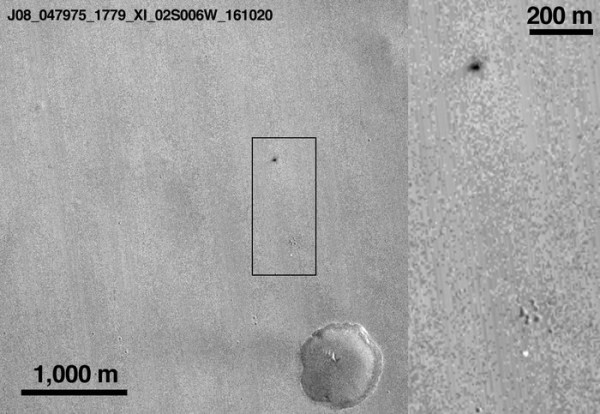By Ana Verayo, | October 22, 2016

The Schiaparelli's entry, descent and landing demonstrator module is seen following the arrival of the module on 19 October.
European Space Agency officials confirmed on Friday that the ExoMars Schiaparelli lander crashed during its touchdown on Mars on Wednesday.
Like Us on Facebook
Using NASA's Mars Reconnaissance Orbiter's low-resolution Context camera, new images have revealed the location of the doomed lander on the surface of Mars. The lander presumably exploded upon impact after its braking rockets shut down just a mile above the surface.
A new series of images by NASA's Martian orbiter reveals a bright feature which is assumed to be Schiaparelli's massive supersonic parachute. Mission scientists believe that the lander crashed into a dark spot measuring 130 by 50 feet on a plain known as Meridiani Planum.
On Wednesday, October 19, the Schiaparelli lander made its way into the Martian atmosphere around 10:42 a.m. EDT. Before this, the lander was deployed by its mothership, the Trace Gas Orbiter, to begin its two-day descent to the Red Planet. The TGO spacecraft was successfully inserted into Martian orbit as the lander was attempting to touchdown on the surface of Mars.
This is the ESA's first attempt to launch a lander on Mars. The Schiaparelli traveled at a speed of 13,000 miles per hour into the tenuous, alien atmosphere with an altitude of 75 miles.
Telemetry data revealed that the lander did survive the scorching heat upon entering the atmosphere of Mars. Therefore, it successfully launched it's braking parachute and heat shields. The original flight plan was to cut this parachute free within less than a mile above the Martian surface, to fire nine smaller rockets for a crucial burn that will gently land the Schiaparelli.
However, a minute before the landing, the lander lost contact when the parachute was deployed. MRO imagery revealed that the Schiaparelli landed on the target site. However, the elaborate string of events did not go as planned.
ESA officials say that the Schiaparelli is estimated to have dropped from 1.2 miles to 2.5 miles and made impact at a speed of more than 186 miles per hour.
Next week, NASA's MRO will continue to capture more images of the crash site, with greater detail using its other camera, the high-resolution HiRISE (High Resolution Imaging Science Experiment) camera.
-
Use of Coronavirus Pandemic Drones Raises Privacy Concerns: Drones Spread Fear, Local Officials Say

-
Coronavirus Hampers The Delivery Of Lockheed Martin F-35 Stealth Fighters For 2020

-
Instagram Speeds Up Plans to Add Account Memorialization Feature Due to COVID-19 Deaths

-
NASA: Perseverance Plans to Bring 'Mars Rock' to Earth in 2031

-
600 Dead And 3,000 In The Hospital as Iranians Believed Drinking High-Concentrations of Alcohol Can Cure The Coronavirus

-
600 Dead And 3,000 In The Hospital as Iranians Believed Drinking High-Concentrations of Alcohol Can Cure The Coronavirus

-
COVID-19: Doctors, Nurses Use Virtual Reality to Learn New Skills in Treating Coronavirus Patients







